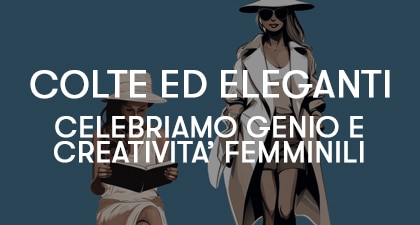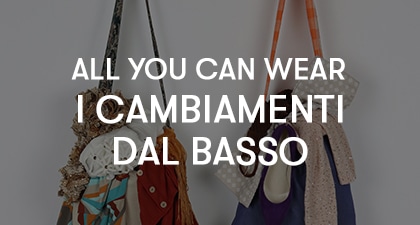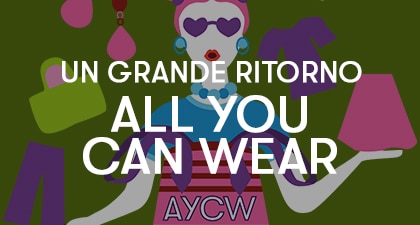
A New Way to Celebrate International Women’s Day
From March 7 to 10, the Cooperativa Di Mano In Mano presents a new way to celebrate cultured and elegant women with a three-dimensional event that combines beauty and creativity, history and insights, shopping and culture.
The focus of the exhibition “Cultured and Elegant” is the creations of four icons of Italian fashion – Biki, Mila Schön, Krizia, Luisa Spagnoli – worn by mannequins that guide the visitor through the exhibition, accompanied by detailed panels, just like in an exhibition.

But that’s not all! Completing the setup is a rich selection of books dedicated to the female world, divided into four categories: history of fashion, great female writers, feminism and gender issues, the perfect woman of the past who now makes us smile (or get angry).
And for the occasion, the Cambiago store of Di Mano in Mano showcases its “new” collection of clothing that winks at spring and the first warm days, with beautiful vintage clothes and accessories, along with a curated selection of second-hand items that are both sought-after and of high quality.
Spotlight on: Biki, Mila Schön, Krizia, Luisa Spagnoli
Biki, Mila Schön, Krizia, and Luisa Spagnoli are the four cultured and elegant women we decided to explore during the event: four designers who helped write the history of fashion, leaving an unmistakable mark that, on one hand, helped spread “Made in Italy” around the world and, on the other, revolutionized dressing as an expression of freedom and emancipation.
Biki (Milan, June 1, 1906 – Milan, February 24, 1999)
Elvira Leonardi Bouyeure, known as Biki, is the first cultured and elegant woman we decided to celebrate. She was born in Milan and spent her childhood in an apartment rented by the Crespi family, owners of Corriere della Sera. In the salon of this large house, Biki came into contact with bourgeois and aristocratic figures, artists, and art critics.
Her career began in 1934 when she opened her first atelier on via Senato and presented a collection of lingerie with the revolutionary idea of creating nightgowns as if they were evening dresses.



In the 1950s, the Biki atelier created clothes for cinema and for increasingly famous clients: from Lucia Bosè to Jeanne Moreau, from Brigitte Bardot to Sophia Loren, from Raffaella Carrà to Isadora Duncan, but most notably for the soprano Maria Callas, for whom she contributed to creating her image (hence the nickname “the Seamstress of Callas”).
Beppe Modenese, president of the National Chamber of Italian Fashion, recalled her after her death: “Her always-open house, her touch of internationality, her class, characterized an era. Biki represented a lot in fashion, but also in Milano society.”
Krizia (Bergamo, January 31, 1925 – Milan, December 6, 2015)
Mariuccia Mandelli, known as Krizia, started at a very young age and opened, together with a friend, a small workshop where she produced her first collections.
“Crazy Krizia” firmly established herself in the world of fashion with her participation in the Samia in Turin in ’57, where her versatile fits, combined with eccentric details, and a contemporary appeal attracted both Italian and international buyers.
The craftsmanship is always accompanied by industrial innovation. Krizia was an tireless researcher of new materials and never-before-seen techniques. Her pieces often revealed unexpected combinations of textures and volumes.



The animal world is another distinctive feature of the designer: an imagery that remains indissolubly linked to the name of Krizia.
Mariuccia is a visionary entrepreneur, who surrounded herself with the right collaborators – Walter Albini and Karl Lagerfeld, do they ring a bell? – and who consecrated the city of Milano as the temple of Italian fashion with what we now know as Fashion Week.
Luisa Spagnoli (Perugia, October 30, 1877 – Paris, September 21, 1935)
It all started with a kiss. Yes, indeed: the Perugina kiss owes its invention to Luisa Spagnoli, who, before dedicating herself to clothing, had opened a small confectionery business in downtown Perugia.
But it is in the field of fashion that her name made history. In the post-war years, it became increasingly difficult to recover quality wool yarns, so in 1928, Spagnoli founded Angora Spagnoli. By breeding angora rabbits, she obtained yarn from the animals’ fur without killing or shearing them, creating fine yarns for cloaks, shawls, and fashionable dresses.



In 1930, she participated with her creations in the Fiera Campionaria di Milano, after which her success began to take off.
After her, her children transformed the business from primarily artisanal to industrial, diversified the production, and developed the commercial network of the “Luisa Spagnoli” stores, now present worldwide.
Mila Schön (Trogir, September 28, 1916 – Quargnento, September 5, 2008)
And here we are with the fourth of our cultured and elegant women: Mila Schön. Always used to wearing the best of Parisian haute-couture, due to her family’s financial setbacks, she found herself designing her own dresses, which she later sold to her friends from the Milanese upper bourgeoisie in the small atelier she opened in 1958, in downtown Milano.
It was an immediate success, and a few years later, she triumphed at the fashion shows at Palazzo Pitti in Florence. What set her apart was an invention that made history: the double-face, a tailoring technique that allows the complete reversibility of the garment.



In 1966, after presenting her collections in Dallas and Houston, she received the Fashion Oscar, the prestigious Neimann Marcus Award. These were the years of her most revolutionary creative phase, where her interest in fashion was closely tied to the world of art.
The wave and optical patterns, the bold combinations of contrasting colors, and the concentric circles are a clear reference to the works of Pollock, Klimt, and Lucio Fontana.
Her clothes were like true works of art, which earned her a spot in the “Cubism and Fashion” exhibition at the Metropolitan Museum of Art in New York.
The event that is part of a more heated debate than ever
In the context of a debate on gender issues, now hotter than ever, the Cooperative has chosen to shine a light on female genius in fashion, which with grace, taste, irreverence, and determination, has been an amplifier of social changes and has paved the way for many conquests in the field of gender equality.
“Cultured and Elegant” awaits you in Cambiago, at Via Castellazzo 8.
From March 7 to 10: Thursday from 3:00 PM to 7:00 PM, Saturday and Sunday from 10:00 AM to 7:00 PM.
For information: www.dimanoinmano.it, 02 95 34 91 93.








